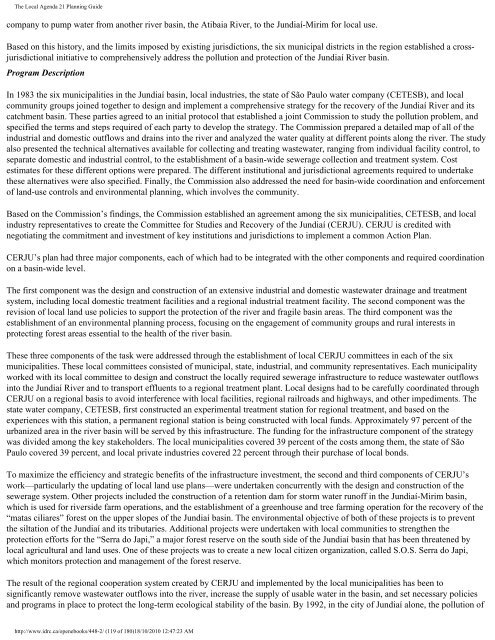The Local Agenda 21 Planning Guide - Democrats Against UN ...
The Local Agenda 21 Planning Guide - Democrats Against UN ...
The Local Agenda 21 Planning Guide - Democrats Against UN ...
Create successful ePaper yourself
Turn your PDF publications into a flip-book with our unique Google optimized e-Paper software.
<strong>The</strong> <strong>Local</strong> <strong>Agenda</strong> <strong>21</strong> <strong>Planning</strong> <strong>Guide</strong><br />
company to pump water from another river basin, the Atibaia River, to the Jundiaí-Mirim for local use.<br />
Based on this history, and the limits imposed by existing jurisdictions, the six municipal districts in the region established a crossjurisdictional<br />
initiative to comprehensively address the pollution and protection of the Jundiaí River basin.<br />
Program Description<br />
In 1983 the six municipalities in the Jundiaí basin, local industries, the state of São Paulo water company (CETESB), and local<br />
community groups joined together to design and implement a comprehensive strategy for the recovery of the Jundiaí River and its<br />
catchment basin. <strong>The</strong>se parties agreed to an initial protocol that established a joint Commission to study the pollution problem, and<br />
specified the terms and steps required of each party to develop the strategy. <strong>The</strong> Commission prepared a detailed map of all of the<br />
industrial and domestic outflows and drains into the river and analyzed the water quality at different points along the river. <strong>The</strong> study<br />
also presented the technical alternatives available for collecting and treating wastewater, ranging from individual facility control, to<br />
separate domestic and industrial control, to the establishment of a basin-wide sewerage collection and treatment system. Cost<br />
estimates for these different options were prepared. <strong>The</strong> different institutional and jurisdictional agreements required to undertake<br />
these alternatives were also specified. Finally, the Commission also addressed the need for basin-wide coordination and enforcement<br />
of land-use controls and environmental planning, which involves the community.<br />
Based on the Commission’s findings, the Commission established an agreement among the six municipalities, CETESB, and local<br />
industry representatives to create the Committee for Studies and Recovery of the Jundiaí (CERJU). CERJU is credited with<br />
negotiating the commitment and investment of key institutions and jurisdictions to implement a common Action Plan.<br />
CERJU’s plan had three major components, each of which had to be integrated with the other components and required coordination<br />
on a basin-wide level.<br />
<strong>The</strong> first component was the design and construction of an extensive industrial and domestic wastewater drainage and treatment<br />
system, including local domestic treatment facilities and a regional industrial treatment facility. <strong>The</strong> second component was the<br />
revision of local land use policies to support the protection of the river and fragile basin areas. <strong>The</strong> third component was the<br />
establishment of an environmental planning process, focusing on the engagement of community groups and rural interests in<br />
protecting forest areas essential to the health of the river basin.<br />
<strong>The</strong>se three components of the task were addressed through the establishment of local CERJU committees in each of the six<br />
municipalities. <strong>The</strong>se local committees consisted of municipal, state, industrial, and community representatives. Each municipality<br />
worked with its local committee to design and construct the locally required sewerage infrastructure to reduce wastewater outflows<br />
into the Jundiaí River and to transport effluents to a regional treatment plant. <strong>Local</strong> designs had to be carefully coordinated through<br />
CERJU on a regional basis to avoid interference with local facilities, regional railroads and highways, and other impediments. <strong>The</strong><br />
state water company, CETESB, first constructed an experimental treatment station for regional treatment, and based on the<br />
experiences with this station, a permanent regional station is being constructed with local funds. Approximately 97 percent of the<br />
urbanized area in the river basin will be served by this infrastructure. <strong>The</strong> funding for the infrastructure component of the strategy<br />
was divided among the key stakeholders. <strong>The</strong> local municipalities covered 39 percent of the costs among them, the state of São<br />
Paulo covered 39 percent, and local private industries covered 22 percent through their purchase of local bonds.<br />
To maximize the efficiency and strategic benefits of the infrastructure investment, the second and third components of CERJU’s<br />
work—particularly the updating of local land use plans—were undertaken concurrently with the design and construction of the<br />
sewerage system. Other projects included the construction of a retention dam for storm water runoff in the Jundiaí-Mirim basin,<br />
which is used for riverside farm operations, and the establishment of a greenhouse and tree farming operation for the recovery of the<br />
“matas ciliares” forest on the upper slopes of the Jundiaí basin. <strong>The</strong> environmental objective of both of these projects is to prevent<br />
the siltation of the Jundiaí and its tributaries. Additional projects were undertaken with local communities to strengthen the<br />
protection efforts for the “Serra do Japi,” a major forest reserve on the south side of the Jundiaí basin that has been threatened by<br />
local agricultural and land uses. One of these projects was to create a new local citizen organization, called S.O.S. Serra do Japi,<br />
which monitors protection and management of the forest reserve.<br />
<strong>The</strong> result of the regional cooperation system created by CERJU and implemented by the local municipalities has been to<br />
significantly remove wastewater outflows into the river, increase the supply of usable water in the basin, and set necessary policies<br />
and programs in place to protect the long-term ecological stability of the basin. By 1992, in the city of Jundiaí alone, the pollution of<br />
http://www.idrc.ca/openebooks/448-2/ (119 of 180)18/10/2010 12:47:23 AM










